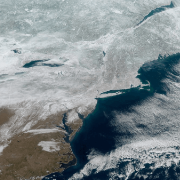-
Posts
34,614 -
Joined
-
Last visited
Content Type
Profiles
Blogs
Forums
American Weather
Media Demo
Store
Gallery
Everything posted by WxWatcher007
-

Major Hurricane Melissa - 892mb - 185mph Jamaica landfall
WxWatcher007 replied to GaWx's topic in Tropical Headquarters
I think this would actually be bad timing for an ERC. If anything, you want it close enough to landfall that it can’t rebound from its peak. A cycle now would just expand the wind field and effectively give Melissa 24 hours to potentially RI again. Note how the 06z HAFS both intensify upon final approach. -

Spooky Season (October Disco Thread)
WxWatcher007 replied to Prismshine Productions's topic in New England
I think I can speak for everyone when I say I’d rather have my Christmas tree and all the presents catch fire than watch @ORH_wxman chime in a tracking thread with “we need major changes”. -

Major Hurricane Melissa - 892mb - 185mph Jamaica landfall
WxWatcher007 replied to GaWx's topic in Tropical Headquarters
Yeah I don’t think there was any reason to take the winds down, especially when the forecast is for 140kt 24 hours from now. -

Spooky Season (October Disco Thread)
WxWatcher007 replied to Prismshine Productions's topic in New England
The first time we go through the ole epic pattern to cutter cycle in December, we’ll see quite a show. -

Spooky Season (October Disco Thread)
WxWatcher007 replied to Prismshine Productions's topic in New England
I can’t do this again. We just started going from drought to active, and the storms are already deamplifying and cutting. I’ll leave my family. I’ll sell my house and live with the moose at Fort Kent. I won’t do another sub 20” winter that people pretend isn’t a rat because January was -1.1°. I just can’t do it. -

Major Hurricane Melissa - 892mb - 185mph Jamaica landfall
WxWatcher007 replied to GaWx's topic in Tropical Headquarters
The last dropsonde found surface winds of 111kt with 128kt at 925mb in the northern section of the eyewall, so while potentially a little high, the NHC is in the ballpark. We’ll see what the next recon flight finds. -

Spooky Season (October Disco Thread)
WxWatcher007 replied to Prismshine Productions's topic in New England
Melissa going nuclear -

Major Hurricane Melissa - 892mb - 185mph Jamaica landfall
WxWatcher007 replied to GaWx's topic in Tropical Headquarters
This is exceptionally rapid organization. 15z on 10/25 04z now, on 10/26 -

Major Hurricane Melissa - 892mb - 185mph Jamaica landfall
WxWatcher007 replied to GaWx's topic in Tropical Headquarters
That is…wow… -

Major Hurricane Melissa - 892mb - 185mph Jamaica landfall
WxWatcher007 replied to GaWx's topic in Tropical Headquarters
I’m guessing that is temporary. The structure is about as good as it gets. Look at this TDR -

Major Hurricane Melissa - 892mb - 185mph Jamaica landfall
WxWatcher007 replied to GaWx's topic in Tropical Headquarters
Hurricane Melissa Discussion Number 18 NWS National Hurricane Center Miami FL AL132025 500 PM EDT Sat Oct 25 2025 Melissa is likely beginning a period of rapid intensification (RI). Since both the NOAA-P3 and Air Force Reserve C-130 aircraft sampled the system this morning, the satellite presentation has continued to improve, with cold -75 to -80 C cloud tops wrapping around the center with hints of an eye starting to appear on visible images. The eye is also becoming better defined on radar images out of Jamaica with an overall diameter of around 20 n mi. In addition, an earlier GMI microwave pass received after the prior advisory showed a well-defined cyan ring on the 37-GHz, which is often a harbinger of RI. Subjective Dvorak intensity estimates were T5.0/90 kt from SAB, and T4.5/77 kt from TAFB. The objective estimates from UW-CIMSS were a little lower, but are also quickly rising, and the initial intensity will be set at 80 kt this advisory, blending these intensity estimates. The hurricane now appears to be moving slowly westward, at an estimated motion of 275/3 kt. A narrow mid-level ridge has built in to the north of Melissa, and should be the main steering feature over the next 24-48 hours to help move the hurricane slowly westward. The deep-layer steering vector still has a slight southward component, and it wouldn't be surprising to even see a little south of due west motion occur, like the Google DeepMind ensembles and ECMWF-AI model have been suggesting in the short-term forecast. After the next couple of days, the ridging to the north becomes quickly eroded by a shortwave trough moving across the southeastern United States. The net result of this changing synoptic pattern is that Melissa is expected to turn rather abruptly northward and northeastward by the early to middle part of next week. Compared to this morning, the track guidance has become more tightly clustered in the across track direction, and even the 12z GFS run, which was previous a eastward outlier, is now in better agreement with the track guidance suite showing a direct landfall in Jamaica. The main uncertainty is related to the amount of acceleration that Melissa will undergo after it turns to the northeast, and there remains large spread in the along-track direction in both the deterministic and ensemble guidance in the day 3-5 time frame. The NHC track forecast is only slightly more poleward compared to the prior forecast over the first 12-24 hours, and convergences very close to the prior track thereafter. This track is roughly a blend of the latest HCCA and GDMI track guidance. On this track, this brings Melissa's core near Jamaica early on Tuesday, and early on Wednesday along the eastern Cuba provinces, where a hurricane watch is now in effect. Rapid intensification appears to have started, and assuming Melissa stays far enough south of Jamaica over the next couple of days, there appear few impediments to its intensification in the short-term. Both the hurricane-regional models and the Google DeepMind ensembles suggest RI could continue for the next 36 to 48 hours. In fact, once again 4/5th s of the latter 50 member ensemble are forecasting a peak intensity of Category 5 intensity. The 12z HAFS-A run also showed a peak intensity of Category 5 in 48 hours, and both HAFS-A/B have been suggesting a similar peak on and off over the past few days. Given the current trends, the NHC intensity forecast now shows a 140 kt peak in 48 hours, in general agreement with this aggressive guidance. Afterwards, some inner-core oscillations such as eyewall replacement cycles could lead to fluctuations in intensity before its first landfall in Jamaica. It is worth stressing that there is very little practical difference in the overall impacts of a Category 4 or 5 landfall, and Melissa is expected to be at least that intensity when moves over Jamaica early next week. Land interaction will likely lead to some weakening as it moves northeastward across Jamaica, but the storm will likely also grow in size and is still forecast to be a major hurricane when it moves over Cuba by the middle of this week. Only after this period that southwesterly shear begins to increase in earnest after it moves into the Southwestern Atlantic. The NHC intensity forecast continues to be on the high end of the overall guidance, siding with the higher intensity aids such as GDMI (which has been the best preforming intensity guidance thus far this year) and HAFS-A, but all the hurricane-regional models show a peak intensity of at least Category 4 intensity. Needless to say, there is a very serious situation, in terms of catastrophic rainfall, wind, and storm surge hazards for Jamaica and preparations should be rushed to completion in the area currently under a Hurricane Warning. Key Messages: 1. Jamaica: A multi-day period of damaging winds and heavy rainfall is expected to begin tonight, causing catastrophic and life-threatening flash flooding and numerous landslides. Extensive infrastructural damage, long-duration power and communication outages, and potentially prolonged isolation of communities is likely. A life-threatening storm surge is also likely along portions of the southern coast early next week. All preparations should be completed today. 2. Haiti: Catastrophic and life-threatening flash flooding and landslides are expected across southwestern Haiti into early next week, likely causing extensive infrastructural damage and potentially prolonged isolation of communities. Strong winds could also potentially last for a day or more over the Tiburon peninsula. 3. Dominican Republic: Heavy rainfall could produce catastrophic flash flooding and numerous landslides in southern portions of the country. 4. Eastern Cuba, Southeast Bahamas, and the Turks and Caicos: Monitor Melissa closely. There is an increasing risk of a significant storm surge, damaging winds, and heavy rainfall by the middle of next week. In eastern Cuba, the risk of life-threatening flash flooding and landslides is increasing. A Hurricane Watch is now in effect for portions of eastern Cuba. FORECAST POSITIONS AND MAX WINDS INIT 25/2100Z 16.6N 75.5W 80 KT 90 MPH 12H 26/0600Z 16.7N 75.9W 100 KT 115 MPH 24H 26/1800Z 16.7N 76.5W 115 KT 130 MPH 36H 27/0600Z 16.7N 77.2W 135 KT 155 MPH 48H 27/1800Z 16.9N 77.6W 140 KT 160 MPH 60H 28/0600Z 17.6N 77.4W 130 KT 150 MPH 72H 28/1800Z 18.8N 76.7W 115 KT 130 MPH 96H 29/1800Z 22.0N 73.4W 90 KT 105 MPH 120H 30/1800Z 27.0N 69.0W 80 KT 90 MPH $$ Forecaster Papin -

Major Hurricane Melissa - 892mb - 185mph Jamaica landfall
WxWatcher007 replied to GaWx's topic in Tropical Headquarters
5:00 PM EDT Sat Oct 25Location: 16.6°N 75.5°WMoving: W at 3 mphMin pressure: 974 mbMax sustained: 90 mph -

Spooky Season (October Disco Thread)
WxWatcher007 replied to Prismshine Productions's topic in New England
The cutter after the cutter? -

Major Hurricane Melissa - 892mb - 185mph Jamaica landfall
WxWatcher007 replied to GaWx's topic in Tropical Headquarters
Organization before intensification -

Spooky Season (October Disco Thread)
WxWatcher007 replied to Prismshine Productions's topic in New England
Low of 33.4 at WXW1 Highly unlikely at this point. The pieces aren’t where they need to be. -

Major Hurricane Melissa - 892mb - 185mph Jamaica landfall
WxWatcher007 replied to GaWx's topic in Tropical Headquarters
HAFS still get this to 140kt+ at 00z so I would look at the Euro with some skepticism tonight. It’s all about the track though. -

Major Hurricane Melissa - 892mb - 185mph Jamaica landfall
WxWatcher007 replied to GaWx's topic in Tropical Headquarters
Yeah no recent microwave passes to confirm. Still, this is probably the most robust it’s looked yet. -

Major Hurricane Melissa - 892mb - 185mph Jamaica landfall
WxWatcher007 replied to GaWx's topic in Tropical Headquarters
It’s off to the races now. -

Major Hurricane Melissa - 892mb - 185mph Jamaica landfall
WxWatcher007 replied to GaWx's topic in Tropical Headquarters
This is such a sensitive track and intensity forecast. Just a few miles south or north would make a huge difference in intensity even though the catastrophic rainfall looks highly likely. -

Spooky Season (October Disco Thread)
WxWatcher007 replied to Prismshine Productions's topic in New England
For a beginner, is there a particular make/model that you’d recommend? -

Major Hurricane Melissa - 892mb - 185mph Jamaica landfall
WxWatcher007 replied to GaWx's topic in Tropical Headquarters
It’ll be crazy to see the transformation in 72 hours. Not as dramatic as Gabrielle, but dramatic nonetheless. -

Spooky Season (October Disco Thread)
WxWatcher007 replied to Prismshine Productions's topic in New England
Actually thinking of getting a snowmobile. Not sure where to start. -

Spooky Season (October Disco Thread)
WxWatcher007 replied to Prismshine Productions's topic in New England
After the decade that’s been we should be used to that by now. Yeah, but let’s see if that disappears at 00z. -

Major Hurricane Melissa - 892mb - 185mph Jamaica landfall
WxWatcher007 replied to GaWx's topic in Tropical Headquarters
They can but the environment is still exceptionally conducive for RI, and HAFS has been excellent in sniffing out the high end solutions. Milton being a prime example from last season. -

Spooky Season (October Disco Thread)
WxWatcher007 replied to Prismshine Productions's topic in New England
Nice to have something to track either way. A C4 getting pulled into Maine was never on the table. Hybrid at best, modest to strong nontropical coastal at worst unless that signal dampens.








